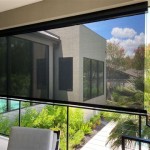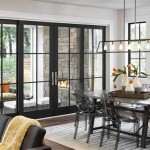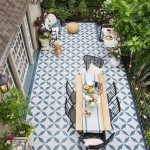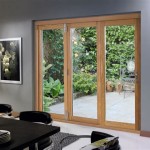Bringing Shade and Comfort to Your Patios
Patios serve as extensions of indoor living spaces, offering opportunities for relaxation, entertainment, and enjoying the outdoors. However, exposure to direct sunlight can render a patio unusable during peak hours, dramatically diminishing its value and comfort. Effective shading solutions are crucial for transforming a patio into a versatile and enjoyable space, mitigating the effects of intense heat and harsh sunlight.
The concept of bringing shade and comfort to patios encompasses a wide range of strategies and products designed to create a more temperate and inviting environment. This can involve selecting the right materials, implementing structural enhancements, and incorporating natural elements. The goal is to create a balance between protection from the elements and connection to the surrounding landscape.
Several factors influence the effectiveness of patio shading. These include the orientation of the patio relative to the sun's path, the local climate, the intended use of the space, and the aesthetic preferences of the homeowner. A comprehensive approach to patio shading considers all these variables to achieve an optimal outcome.
Understanding the Benefits of Patio Shading
The primary benefit of patio shading is, unsurprisingly, the reduction of direct sunlight exposure. This results in a cooler and more comfortable outdoor environment, allowing occupants to spend more time on the patio without suffering from overheating or sunburn. The reduction in heat also minimizes glare, improving visibility and creating a more relaxing atmosphere.
Beyond comfort, shading solutions contribute to energy efficiency. By reducing the amount of solar heat entering the home through patio doors and windows, shading structures can lower cooling costs, particularly during the summer months. This can lead to significant savings on energy bills and a reduced carbon footprint. Strategies include not only external shading but utilizing interior window treatments that complement the design.
Furthermore, patio shading can protect outdoor furniture and accessories from the damaging effects of UV radiation. Prolonged exposure to sunlight can cause fading, cracking, and deterioration of materials such as fabrics, plastics, and wood. By providing shade, homeowners can extend the lifespan of their patio furnishings and minimize the need for replacements.
Shading structures also provide a sense of privacy. Depending on the design and materials used, shading solutions can create a visual barrier between the patio and neighboring properties or public spaces. This can enhance the feeling of seclusion and relaxation, making the patio a more private and enjoyable retreat. The degree of privacy can be adjusted through the choice of materials, such as solid panels or latticework.
Finally, the addition of shade structures can significantly enhance the aesthetic appeal of a patio. Well-designed pergolas, awnings, or shade sails can add visual interest and architectural character to the outdoor space, complementing the overall design of the home and landscape. The aesthetic enhancements can lead to increased property value.
Exploring Different Patio Shading Options
Numerous options exist for providing shade and comfort to a patio, each with its own advantages and disadvantages. The selection of the most appropriate solution depends on factors such as budget, space constraints, architectural style, and desired level of shade.
Pergolas are a popular choice for adding a touch of elegance and architectural interest to a patio. These open-framework structures can be constructed from a variety of materials, including wood, metal, and vinyl. Pergolas provide partial shade by filtering sunlight through their open lattice design. The amount of shade can be increased by adding climbing plants, such as vines or wisteria, which provide additional coverage as they grow. Pergolas are often considered permanent structures, adding value to the property.
Awnings are another effective option for providing shade, particularly for patios adjacent to the house. Awnings can be either retractable or fixed, allowing users to adjust the amount of shade as needed. Retractable awnings offer flexibility, allowing homeowners to enjoy full sun during cooler months and shade during hotter periods. Awnings are available in a wide range of colors, styles, and materials, making it easy to find a design that complements the home's architecture.
Shade sails are a more contemporary option that can add a unique and stylish touch to a patio. These fabric canopies are suspended between multiple anchor points, creating a shaded area with a sculptural appearance. Shade sails are available in various shapes, sizes, and colors, and can be customized to fit the specific dimensions of the patio. They are relatively easy to install and can be removed during the off-season.
Umbrellas are a portable and versatile option for providing shade to specific areas of the patio. Patio umbrellas are available in a variety of sizes and styles, including freestanding models and those that attach to patio tables. Umbrellas offer flexibility, allowing users to move them as needed to follow the sun's path. While practical, umbrellas may not provide the same level of architectural enhancement as more permanent structures.
Trees and landscaping offer a natural and aesthetically pleasing way to provide shade to a patio. Planting trees strategically around the patio can create a cooling effect through transpiration and provide a natural barrier against direct sunlight. The selection of tree species should consider factors such as growth rate, size at maturity, and leaf density. Deciduous trees provide shade during the summer months while allowing sunlight to reach the patio during the winter. Trellises supporting climbing plants can also be used to create a living wall of shade.
Key Considerations for Effective Patio Shading
Successfully implementing a patio shading solution requires careful planning and consideration of several key factors. These factors ensure that the chosen solution effectively meets the needs of the homeowner while also enhancing the aesthetics and functionality of the outdoor space.
One crucial consideration is the orientation of the patio. Patios facing south or west receive the most intense sunlight, particularly during the afternoon hours. These patios may require more robust shading solutions to provide adequate protection. Patios facing north or east receive less direct sunlight and may benefit from lighter shading options. Understanding the sun's path throughout the day is essential for determining the optimal placement and design of shading structures.
The local climate also plays a significant role in determining the appropriate shading solution. Regions with hot, sunny climates may require more substantial shade structures to provide adequate protection from the heat. Regions with milder climates may benefit from lighter, more flexible shading options. Consider factors such as rainfall, wind, and humidity when selecting materials and designs. For example, in windy areas, shade sails may need to be installed with greater anchoring strength.
The intended use of the patio should also be considered when selecting a shading solution. If the patio is primarily used for dining, a large awning or pergola may be necessary to cover the entire seating area. If the patio is used for lounging or relaxation, a more flexible shading solution such as umbrellas or shade sails may be sufficient. Consider how the shading solution will impact the functionality of the patio for various activities. This includes ensuring adequate lighting for evening use.
The integration of the shading solution with the existing architecture of the home and landscape is also important. The shading structure should complement the style of the home and blend seamlessly with the surrounding environment. Consider the materials, colors, and design of the shading solution to ensure that it enhances the overall aesthetic appeal of the outdoor space. Professional design consultation can be invaluable for achieving a cohesive and visually appealing result.
Finally, budget considerations are essential when selecting a patio shading solution. The cost of different options can vary widely, depending on factors such as materials, size, and complexity of installation. Establish a realistic budget before beginning the project and explore different options that fit within the allocated funds. Consider the long-term benefits of each option, such as energy savings and increased property value, when making a decision.
By carefully considering these key factors, homeowners can create a patio that is both comfortable and aesthetically pleasing, enhancing their enjoyment of the outdoor space for years to come.

10 Smart Ways To Bring Shade Your Outdoor Space Bob Vila

26 Patio Shade Ideas To Help You Stay Cool Timbertech

Shade Solutions And Ideas For Decks Porches Patios Com

11 Excellent Backyard Patio Shade Ideas To Upgrade Your Space Structureworks

15 Creative Pergola Ideas For Patio Perfection Struxure

10 Shady Patio Ideas For Landscaping Oasis Landscapes Irrigation

25 Best Patio Cover Ideas Covered Designs

Backyard Oasis Meaning The Essentials Of A Peaceful Outdoor Space

Benefits Of A Pergola Vs Other Patio Covers Azenco

36 Patio Cover Ideas That Make Outdoor Living A Breeze Architectural Digest
Related Posts








